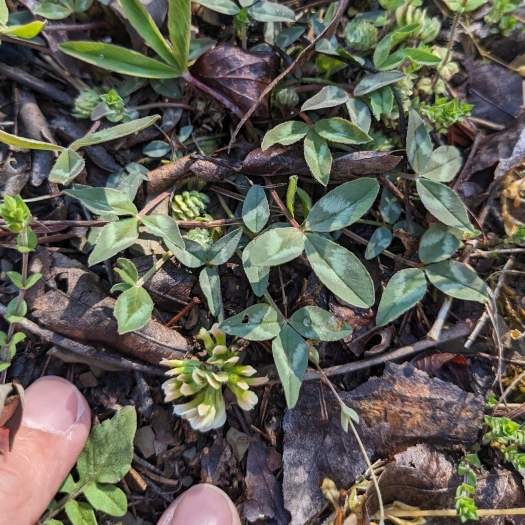Kate’s Mountain Clover
(Trifolium virginicum)
Kate’s Mountain Clover (Trifolium virginicum)
/
/

Adrienne van den Beemt
CC BY 4.0
Image By:
Adrienne van den Beemt
Recorded By:
Copyright:
CC BY 4.0
Copyright Notice:
Photo by: Adrienne van den Beemt | License Type: CC BY 4.0 | License URL: http://creativecommons.org/licenses/by/4.0/ | Rights Holder: Adrienne van den Beemt | Publisher: iNaturalist | Date Created: 2024-04-20T09:33:15-07:00 |


Estimated Native Range
Summary
Trifolium virginicum, commonly known as Kate’s Mountain clover, is a perennial herb that is native to the Appalachian shale barrens of West Virginia and Virginia. It is a rare species, often found in harsh, dry, and rocky soils that are low in nutrients. This plant is the symbol of the West Virginia Native Plant Society, reflecting its conservation importance and restricted habitat. Typically, it grows to a modest size, with a height of about 6-12 inches (15-30 cm). Kate’s Mountain clover has trifoliate leaves and produces small, rounded clusters of white to pale pink flowers in late spring to early summer. The flowers are modest in size but can be quite showy due to their abundance.
In cultivation, Kate’s Mountain clover is valued for its unique appearance and its ability to thrive in poor soils, making it an interesting choice for rock gardens and restoration projects in its native range. It requires full sun to part shade and well-drained soils, reflecting its adaptation to the challenging conditions of shale barrens. While not widely used in cultivation due to its rarity, it can serve as a conversation piece in native plant gardens and educational settings. Gardeners should be aware that due to its specialized habitat requirements and conservation status, it may not be suitable for widespread cultivation.CC BY-SA 4.0
In cultivation, Kate’s Mountain clover is valued for its unique appearance and its ability to thrive in poor soils, making it an interesting choice for rock gardens and restoration projects in its native range. It requires full sun to part shade and well-drained soils, reflecting its adaptation to the challenging conditions of shale barrens. While not widely used in cultivation due to its rarity, it can serve as a conversation piece in native plant gardens and educational settings. Gardeners should be aware that due to its specialized habitat requirements and conservation status, it may not be suitable for widespread cultivation.CC BY-SA 4.0
Plant Description
- Plant Type: Herb
- Height: 0.5-1 feet
- Width: 0.5-1 feet
- Growth Rate: Moderate
- Flower Color: White, Pink
- Flowering Season: Spring, Summer
- Leaf Retention: Deciduous
Growth Requirements
- Sun: Full Sun, Part Shade
- Water: Medium
- Drainage: Medium, Fast
Common Uses
Bee Garden, Butterfly Garden, Low Maintenance
Natural Habitat
Appalachian shale barrens of West Virginia and Virginia
Other Names
Common Names: Virginia Clover, Large-Head Clover
Scientific Names: , Trifolium virginicum, Trifolium reflexum var. virginicum,
GBIF Accepted Name: